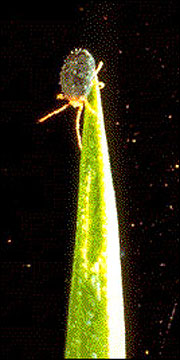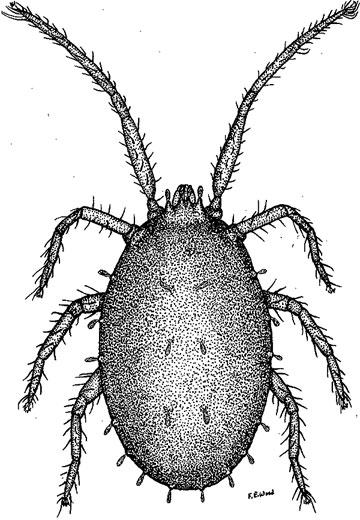The clover mite, Bryobia praetiosa Koch, is a tiny relative of spiders and ticks. Thousands of clover mites can appear during spring or fall, and they are often found crawling around windows or other areas of a house. Clover mites are distinguished from other species of household-invading mites by their reddish-green color and long front legs (Figure 1). The front legs are as long as the body and almost twice the length of the other legs. These distinguishing features can be seen with the aid of a magnifying glass.
Vast numbers of clover mites can invade a house through cracks and tiny openings around windows and doors. Clover mites do not bite people or pets and do not damage the house or furniture, but they can stain light-colored walls, carpet, fabrics or papers when crushed.
Clover mites are plant feeders, and obtain nutrients by sucking plant juices. They usually prefer clovers and lawn grasses but will also feed on certain ornamental shrubs and trees. An abundance of soil nutrients appears to be linked to clover mite populations. Larger populations of clover mites are often associated with newly established lawns or old lawns that have been heavily fertilized. A heavy growth of well-fertilized grass growing against the foundation of a house is often the source of an infestation.

 Figure 1. Clover mite.
Figure 1. Clover mite.
Life history
Female clover mites lay bright red eggs in protected areas such as cracks and crevices, where they stay relatively dry. Females lay viable eggs without mating (parthenogenesis); no males are known to exist. The eggs hatch during spring and fall when temperatures are between 70 and 85 degrees F. The resulting offspring are genetically identical to the mother. Clover mites begin to feed on plant juices right after hatching. They progress through four stages of development: larva, protonymph, deutonymph and adult. Only the adults lay eggs. Although clover mites live only a few weeks, usually five or six generations hatch in a year.
Clover mites are generally active during spring and fall, when temperatures are moderate. They are usually inactive during temperature extremes in summer and winter. In spring, feeding and egg laying increases until temperatures reach 85 degrees F. Adults and eggs are dormant during summer when temperatures rise above 85 degrees F. When cooler temperatures return in the fall, the eggs hatch, and feeding and egg laying activities continue until winter. Adult mites and eggs overwinter in protected areas. Clover mites generally remain inactive throughout the winter but can become active during brief periods of warm weather during late winter and early spring.
Physical control
Prevention is the most important step in controlling populations of clover mites. Caulking exterior cracks around doors and windows or in the foundation often deters the migration of clover mites into a house.
Creating a zone free of grass and weeds around the foundation of a house can also minimize clover mite invasions. A grass-free zone 18 to 24 inches wide, especially on the south, southwest and east sides of the house, can provide an effective barrier. These areas can be left barren or covered with mulch or pea gravel, which mites have difficulty crawling across. Flowerbeds planted with zinnia, marigold, salvia, rose, chrysanthemum and petunia, or shrubs such as barberry, juniper, spruce, arborvitae and yew make better barriers because these plants are not attractive to clover mites.
If mites do enter the house, vacuuming will collect many of them around windowsills, walls and elsewhere without crushing them. Be sure to seal the vacuum bag before disposal.
Chemical control
When properly applied and maintained, insecticide or miticide sprays can provide temporary control of heavy infestations. However, physical control measures are necessary for longer-term control.
- Outside
Use an over-the-counter outdoor insecticide labeled to control mites. Create a barrier by spraying 2 feet high on the wall and 2 feet wide on the ground along the base of the house below where clover mites are seen inside. Spray the foundation and outside wall to the point of runoff. Repeat this application as needed throughout the season when clover mites are entering the house. - Inside
An over-the-counter indoor insecticide can be used to kill clover mites that have entered the house. Using a light spray, apply it directly on the crawling mites.
Use pesticides wisely and safely
- Apply only where needed or justified.
- Use care when handling, mixing or applying.
- Keep in original containers complete with labels.
- Keep out of reach of children.
- Read, understand and follow directions on the label and heed all precautions.
- Carefully and properly dispose of unused portions of diluted sprays and empty containers.
- Do not contaminate food or dishes.